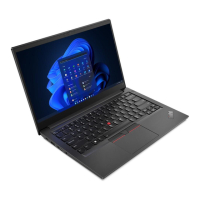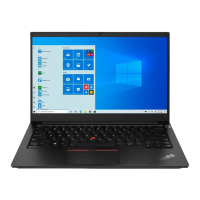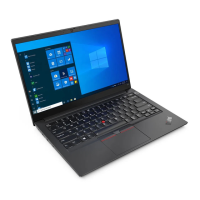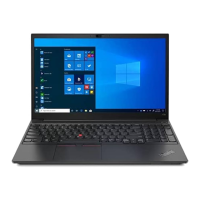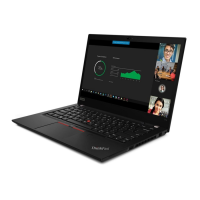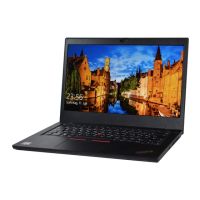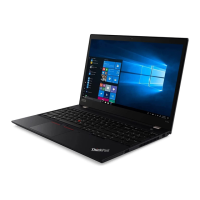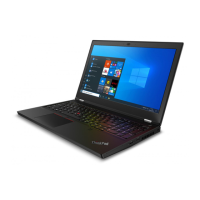Do you have a question about the Lenovo ThinkPad E14 Gen 2 and is the answer not in the manual?
Describes the front components of the computer, including microphones and camera.
Details the components of the computer's base for specific models.
Details the components of the computer's base for specific models.
Describes the ports and connectors located on the left side of the computer.
Describes the ports and connectors located on the right side of the computer.
Lists the detailed technical specifications of the computer.
Explains factors affecting USB data transfer speeds and performance.
Basic introduction to Windows 10 and initial setup for use.
Guidance on creating and using Windows user or Microsoft accounts.
Overview of the Windows 10 desktop, taskbar, and icons.
Information about the Windows 10 Genuine Microsoft label.
Steps to connect to wired Ethernet and Wi-Fi networks.
Instructions for pairing and connecting Bluetooth-enabled devices.
Information on Lenovo Vantage utility for system maintenance and settings.
Guides on using keyboard shortcuts, TrackPoint, and trackpad.
Explains various keyboard shortcuts for efficient computer operation.
Guide to using the TrackPoint for navigation and control.
Instructions on trackpad functions and multi-finger gestures.
Using audio features, the camera, and connecting external displays.
Connecting and using audio devices like speakers and headphones.
Instructions for using the built-in camera for photos and videos.
How to connect and configure external monitors for extended display.
Managing power settings for optimal performance and battery life.
Checking battery levels and procedures for charging the computer.
Using USB-C to charge other compatible devices.
Tips and settings to extend the computer's battery duration.
Customizing the functions of the computer's power button.
Configuring power saving modes for optimal performance and energy efficiency.
Enabling or disabling airplane mode and its impact on wireless features.
Information on buying accessories and upgrades for the computer.
Securing the computer physically using a cable lock.
Managing UEFI BIOS passwords: types, setting, changing, removing, and recovery procedures.
Enrolling and using the fingerprint reader for secure login.
Protecting the computer with pre-installed security software.
Introduction to UEFI BIOS, its purpose, and how to access it.
Modifying the boot device order for system startup.
Adjusting the computer's system date and time.
Steps for downloading and installing UEFI BIOS updates.
Restoring system files, files from backup, and resetting the computer.
Accessing advanced startup and recovery options for troubleshooting.
How Windows automatically attempts recovery from startup failures.
Creating and using a bootable USB drive for system recovery.
Guide to installing the operating system and necessary device drivers.
Explanation of Customer Replaceable Units (CRUs) and their types.
Steps to disable Fast Startup and the built-in battery before CRU replacement.
Procedure for removing and replacing the computer's base cover.
Instructions for safely replacing the computer's RAM module.
Procedure for replacing the internal storage drive (HDD/SSD).
Step-by-step guide for replacing an M.2 solid-state drive.
Instructions for replacing the computer's speaker components.
Common user questions and their corresponding answers for troubleshooting.
Lists common error messages with recommended solutions and actions.
Using Lenovo SmartBeep technology to diagnose beep error codes via smartphone.
Information on accessing support resources like Lenovo Vantage and websites.
Guidance on preparing for and contacting Lenovo customer support.
Information on obtaining technical support and contact details.
Information on purchasing extended warranty and additional support services.
General safety guidelines and precautions for using the computer.
Warnings and advice on managing heat generated by the computer's base and palm rest.
Warnings and advice on managing heat generated by the AC power adapter.
Advisories to keep the computer dry and avoid spills.
Guidelines for protecting cables from physical damage and stress.
Steps to ensure data safety when moving or transporting the computer.
Advice on gentle handling and safe carrying methods for the computer.
Situations requiring immediate attention or professional inspection.
Information on authorized service providers and customer upgrades.
Safety guidelines for using power cords and adapters.
Safety advice for using extension cords and power strips.
Safety precautions related to electrical outlets, plugs, and wiring.
General safety notices for rechargeable and coin-cell batteries.
Guidelines for proper ventilation and heat management to prevent overheating.
Safety precautions related to electrical currents, connections, and storms.
Warnings and handling advice for the liquid crystal display (LCD) screen.
Advice on safe usage of earphones and headphones to prevent hearing damage.
Warnings about small parts and plastic bags posing hazards to children.
Precautions and handling advice for product parts made of glass.
Steps to prevent damage to components from static electricity.
Recommended environmental conditions (altitude, temperature, humidity) for computer operation.
Basic tips for cleaning and maintaining the computer for optimal performance.
Lenovo's commitment to users with disabilities and available resources.
List of keyboard shortcuts to enhance computer accessibility.
How to access and utilize Windows accessibility tools like Magnifier and Narrator.
Using voice commands to control the computer and its functions.
Information on technologies assisting visually impaired users with screen content.
How to adjust screen settings for better text and image readability.
Changing item sizes on screen for improved visibility and ease of use.
Guidelines for setting up the workspace and adopting healthy habits for comfort.
Tips for maintaining good posture and taking breaks to prevent discomfort.
Optimal display positioning, viewing distance, and brightness settings.
Guidance on proper head, chair, arm, hand, and leg posture.
Adapting ergonomic principles for mobile or casual computer use.
Information regarding eye fatigue and visual discomfort when using the computer.
Statements regarding compliance with radio frequency and safety standards.
General information on wireless features and RF safety guidelines.
Details on environmental compliance, recycling programs, and WEEE regulations.
Recycling guidelines for computers and monitors in Japan.
Proper methods for disposing of used lithium batteries from Lenovo computers.
EU directives and labeling requirements for battery recycling.
Restricted substances information compliant with Taiwan regulations.
Federal Communications Commission (FCC) compliance statements for emissions.
Important legal notices, disclaimers, and warranty terms.
List of registered trademarks associated with Lenovo and its products.
Describes the front components of the computer, including microphones and camera.
Details the components of the computer's base for specific models.
Details the components of the computer's base for specific models.
Describes the ports and connectors located on the left side of the computer.
Describes the ports and connectors located on the right side of the computer.
Lists the detailed technical specifications of the computer.
Explains factors affecting USB data transfer speeds and performance.
Basic introduction to Windows 10 and initial setup for use.
Guidance on creating and using Windows user or Microsoft accounts.
Overview of the Windows 10 desktop, taskbar, and icons.
Information about the Windows 10 Genuine Microsoft label.
Steps to connect to wired Ethernet and Wi-Fi networks.
Instructions for pairing and connecting Bluetooth-enabled devices.
Information on Lenovo Vantage utility for system maintenance and settings.
Guides on using keyboard shortcuts, TrackPoint, and trackpad.
Explains various keyboard shortcuts for efficient computer operation.
Guide to using the TrackPoint for navigation and control.
Instructions on trackpad functions and multi-finger gestures.
Using audio features, the camera, and connecting external displays.
Connecting and using audio devices like speakers and headphones.
Instructions for using the built-in camera for photos and videos.
How to connect and configure external monitors for extended display.
Managing power settings for optimal performance and battery life.
Checking battery levels and procedures for charging the computer.
Using USB-C to charge other compatible devices.
Tips and settings to extend the computer's battery duration.
Customizing the functions of the computer's power button.
Configuring power saving modes for optimal performance and energy efficiency.
Enabling or disabling airplane mode and its impact on wireless features.
Information on buying accessories and upgrades for the computer.
Securing the computer physically using a cable lock.
Managing UEFI BIOS passwords: types, setting, changing, removing, and recovery procedures.
Enrolling and using the fingerprint reader for secure login.
Protecting the computer with pre-installed security software.
Introduction to UEFI BIOS, its purpose, and how to access it.
Modifying the boot device order for system startup.
Adjusting the computer's system date and time.
Steps for downloading and installing UEFI BIOS updates.
Restoring system files, files from backup, and resetting the computer.
Accessing advanced startup and recovery options for troubleshooting.
How Windows automatically attempts recovery from startup failures.
Creating and using a bootable USB drive for system recovery.
Guide to installing the operating system and necessary device drivers.
Explanation of Customer Replaceable Units (CRUs) and their types.
Steps to disable Fast Startup and the built-in battery before CRU replacement.
Procedure for removing and replacing the computer's base cover.
Instructions for safely replacing the computer's RAM module.
Procedure for replacing the internal storage drive (HDD/SSD).
Step-by-step guide for replacing an M.2 solid-state drive.
Instructions for replacing the computer's speaker components.
Common user questions and their corresponding answers for troubleshooting.
Lists common error messages with recommended solutions and actions.
Using Lenovo SmartBeep technology to diagnose beep error codes via smartphone.
Information on accessing support resources like Lenovo Vantage and websites.
Guidance on preparing for and contacting Lenovo customer support.
Information on obtaining technical support and contact details.
Information on purchasing extended warranty and additional support services.
General safety guidelines and precautions for using the computer.
Warnings and advice on managing heat generated by the computer's base and palm rest.
Warnings and advice on managing heat generated by the AC power adapter.
Advisories to keep the computer dry and avoid spills.
Guidelines for protecting cables from physical damage and stress.
Steps to ensure data safety when moving or transporting the computer.
Advice on gentle handling and safe carrying methods for the computer.
Situations requiring immediate attention or professional inspection.
Information on authorized service providers and customer upgrades.
Safety guidelines for using power cords and adapters.
Safety advice for using extension cords and power strips.
Safety precautions related to electrical outlets, plugs, and wiring.
General safety notices for rechargeable and coin-cell batteries.
Guidelines for proper ventilation and heat management to prevent overheating.
Safety precautions related to electrical currents, connections, and storms.
Warnings and handling advice for the liquid crystal display (LCD) screen.
Advice on safe usage of earphones and headphones to prevent hearing damage.
Warnings about small parts and plastic bags posing hazards to children.
Precautions and handling advice for product parts made of glass.
Steps to prevent damage to components from static electricity.
Recommended environmental conditions (altitude, temperature, humidity) for computer operation.
Basic tips for cleaning and maintaining the computer for optimal performance.
Lenovo's commitment to users with disabilities and available resources.
List of keyboard shortcuts to enhance computer accessibility.
How to access and utilize Windows accessibility tools like Magnifier and Narrator.
Using voice commands to control the computer and its functions.
Information on technologies assisting visually impaired users with screen content.
How to adjust screen settings for better text and image readability.
Changing item sizes on screen for improved visibility and ease of use.
Guidelines for setting up the workspace and adopting healthy habits for comfort.
Tips for maintaining good posture and taking breaks to prevent discomfort.
Optimal display positioning, viewing distance, and brightness settings.
Guidance on proper head, chair, arm, hand, and leg posture.
Adapting ergonomic principles for mobile or casual computer use.
Information regarding eye fatigue and visual discomfort when using the computer.
Statements regarding compliance with radio frequency and safety standards.
General information on wireless features and RF safety guidelines.
Details on environmental compliance, recycling programs, and WEEE regulations.
Recycling guidelines for computers and monitors in Japan.
Proper methods for disposing of used lithium batteries from Lenovo computers.
EU directives and labeling requirements for battery recycling.
Restricted substances information compliant with Taiwan regulations.
Federal Communications Commission (FCC) compliance statements for emissions.
Important legal notices, disclaimers, and warranty terms.
List of registered trademarks associated with Lenovo and its products.
| Storage | Up to 1TB PCIe SSD |
|---|---|
| Operating System | Windows 10 Pro |
| Weight | Starting at 1.59 kg (3.5 lbs) |
| Webcam | 720p HD with ThinkShutter |
| Display | 14" FHD (1920 x 1080) IPS, anti-glare |
| RAM | Up to 16GB DDR4 |
| Graphics | Intel UHD Graphics |
| Battery | Up to 45Wh or 57Wh |
| Dimensions | 17.9 mm |
| Ports | 1 x USB 2.0, 2 x USB 3.2 Gen 1, HDMI 1.4b, RJ-45, headphone / mic combo |
| Wireless | Wi-Fi 6 |
| Security | dTPM 2.0, Kensington lock slot, Fingerprint reader (optional) |
